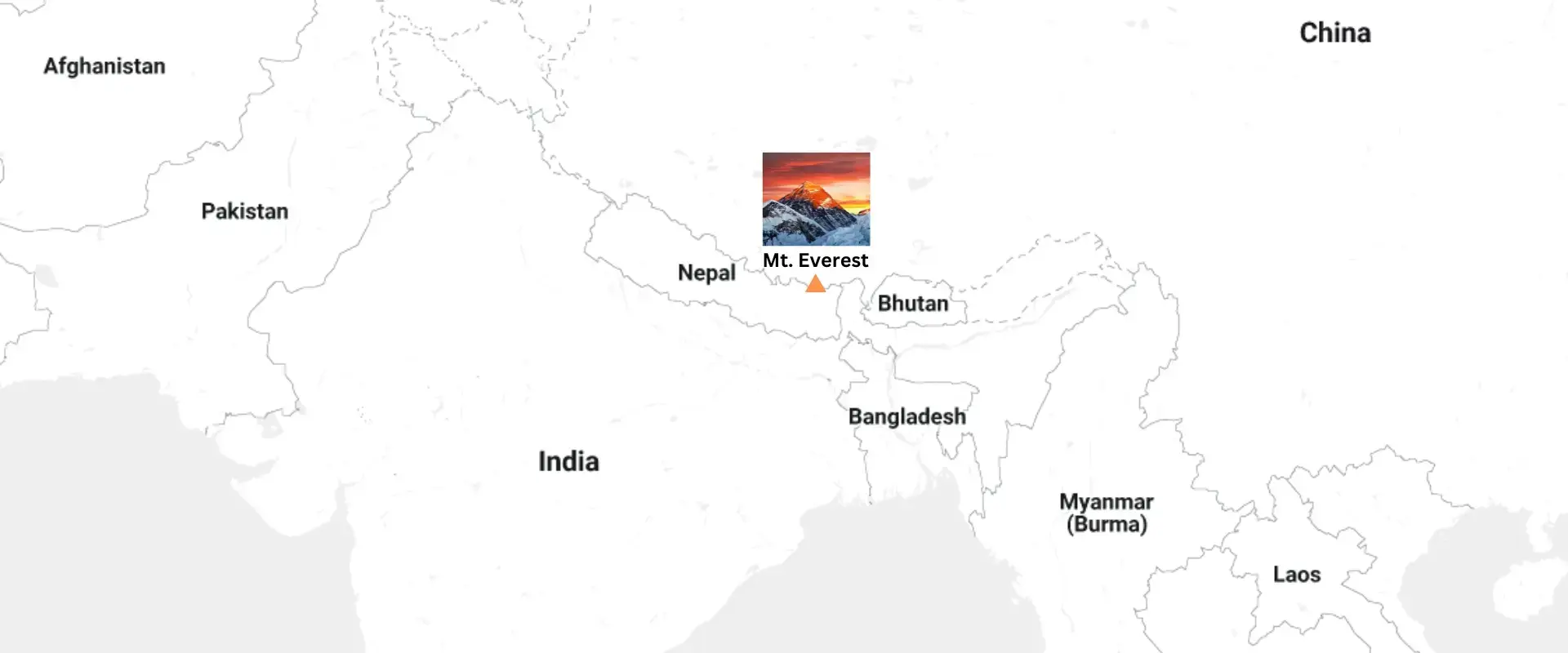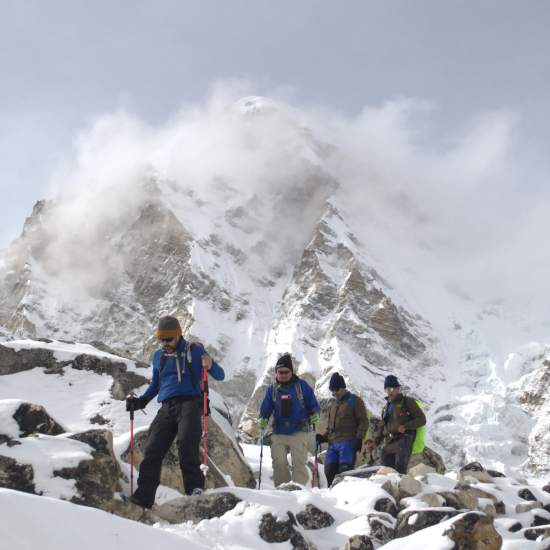When you think of the tallest mountain in the world, one name immediately springs to mind: Everest. But where exactly is this colossal peak located? Let’s embark on a virtual journey to explore its precise location and significance.
Mount Everest sits on the international border between Nepal and the Tibet Autonomous Region of China. The summit’s geographic coordinates are roughly 27.9881° N latitude, 86.9250° E longitude — place that point on any world map and you’ll find the highest point on Earth. (Wikipedia)
On a map, Mount Everest is located at 27.9881° N, 86.9250° E, on the crest of the Mahalangur Himal sub-range of the Himalaya, where Nepal’s Solukhumbu District (Koshi Province) meets China’s Tingri County in Xigazê (Tibet). The summit lies on the international boundary.
Why that location matters (map context)
-
Continental position: Everest sits in southern Asia on the Himalayan arc that separates the Indian subcontinent from the Tibetan Plateau. On a world map it’s north of India and west of central Tibet.
-
Local context: On Nepal’s side the mountain lies inside Sagarmatha National Park (Solukhumbu District). On the Chinese side it’s in Tingri County, Xigazê Prefecture, Tibet. These administrative labels help when using political or regional maps.
Exact coordinates and how to use them on a map
-
Latitude / Longitude (decimal): 27.9881° N, 86.9250° E (often shown as 27°59′ N, 86°55′ E). Use these values in Google Maps, OpenStreetMap, GPS devices, or GIS software to jump straight to the summit.
-
If you prefer degrees/minutes/seconds: approximately 27°59′9″ N, 86°55′21″ E. Enter either format into mapping tools.
Map types and what they show
-
Political maps: show the Nepal–China border crossing the summit; useful for understanding which provinces/districts share the mountain.
-
Topographic maps: show contour lines, ridges (e.g., the South Col and North Col routes), and neighboring peaks like Lhotse and Nuptse; essential for mountaineers and accurate visual placement.
-
Satellite/imagery maps: show glaciers (Khumbu Glacier on the Nepal side, Rongbuk on the Tibet side) and base-camp approaches. Use high-resolution satellite tiles in Google Earth or similar tools.
Height and authoritative measurement (map label importance)
Maps and atlases often label Everest’s elevation as 8,848.86 meters (29,031.7 feet) — the figure jointly announced by Nepal and China in December 2020 and now widely used on modern maps and educational resources. Use that number when precise elevation matters on maps.

Everest is a formidable giant in the heart of the Himalayas, straddling the border between Nepal and the Tibet Autonomous Region of China.
While its summit marks the international boundary, understanding Everest's location also means exploring its intricate geography. The mountain is part of the Mahalangur Himal sub-range, a section of the mighty Himalayas. Its precise coordinates are approximately 27.9881° N, 86.9250° E. However, these numbers only tell part of the story.
For those dreaming of climbing Mount Everest, understanding its location is intrinsically linked to understanding the challenging terrain and the various climbing routes to the summit. The mountain’s features, such as the treacherous Khumbu Icefall, the challenging Western Cwm, and the final push from the South Summit, are crucial elements in any Everest expedition.
The most popular route, the South Col route, begins on the Nepalese side. Climbers typically establish their Advanced Base Camp (ABC) in the Western Cwm, a high-altitude valley carved by glaciers. From there, they ascend through the South Col, a high pass between Everest and Lhotse, before making their final summit push. The North Face, on the Tibetan side, presents a different set of challenges and is less frequently climbed.
So, while you can pinpoint Everest's location on a map, its true essence lies in its majestic presence amidst the Himalayas, its challenging terrain, and its enduring allure for those who dare to dream of reaching the top of the world. Whether you're an armchair adventurer or a seasoned mountaineer, understanding where Mount Everest is located is the first step in appreciating its grandeur and the incredible feats of those who have climbed Mount Everest.
Trek the Everest Base Camp Trek
This classic trek takes you through the heart of the Khumbu region, past vibrant Sherpa villages, ancient monasteries, and towering Himalayan peaks.
Geographical Location:
- Countries: Nepal and China (Tibet)
- Mountain Range: Himalayas
- Sub-range: Mahalangur Himal
- Coordinates: 27°59′17″N 86°55′31″E
Why is Everest So Special?
Beyond its sheer height, Everest is steeped in cultural and spiritual significance. Known as "Sagarmatha" in Nepali and "Chomolungma" in Tibetan, it is revered by the local people as the "Goddess of the Sky." The mountain has drawn adventurers and explorers from around the globe for centuries, with its challenges and rewards capturing the imagination of millions. Summiting Everest represents the pinnacle of human endurance and determination.
Places to Explore in the Everest Region
The Everest region, known as the Khumbu region, offers a treasure trove of breathtaking landscapes, vibrant cultures, and thrilling adventures. Here are some must-visit places:
- Everest Base Camp: The ultimate destination for many trekkers, Everest Base Camp (5,364 meters/17,598 feet) offers unparalleled views of the world's highest peak. This iconic journey provides a close-up look at the mountain that has inspired so many.
- Namche Bazaar: Often referred to as the gateway to Everest, this bustling Sherpa town sits at 3,440 meters (11,290 feet) and is a vital acclimatization stop for trekkers. It offers a fascinating glimpse into Sherpa culture and hospitality.
- Tengboche Monastery: Perched at 3,867 meters (12,687 feet), Tengboche Monastery, built in the 20th century, is the spiritual heart of the Khumbu region. Surrounded by stunning mountain scenery, this serene retreat is a haven for those seeking peace and reflection.
- Gokyo Lakes: A hidden gem in the Everest region, the Gokyo Lakes are a series of pristine glacial lakes set at high altitudes. The crystal-clear waters reflect the surrounding peaks, creating a surreal and serene landscape.
- For those seeking the most iconic view of Everest, Kala Patthar (5,545 meters/18,192 feet) is the place to be. The sunrise here, with Everest bathed in golden light, is a sight that will be etched in your memory forever.
Trek the Gokyo Lake Trek
This trek features stunning turquoise glacial lakes and panoramic views of the world’s tallest peaks, including Mount Everest, Lhotse, Makalu, and Cho Oyu.
Practical tips to find Everest fast
Open Google Maps or OpenStreetMap and paste 27.9881, 86.9250 into the search box.
Zoom into the Himalayan crest between Nepal and China; you’ll see labels for Everest, nearby Lhotse, and the Khumbu region.
For navigation or GIS, set the map projection to WGS84 (latitude/longitude) — that’s the standard used by GPS and the coordinate values above.
Common SEO queries answered
Where is Mount Everest on a map? — On the Nepal–China border at 27.9881° N, 86.9250° E.
Which country is Mount Everest in? — The summit lies on the border shared by Nepal and China (Tibet Autonomous Region).
What are the nearest administrative regions? — Solukhumbu District, Koshi Province (Nepal) and Tingri County, Xigazê Prefecture (Tibet, China).
What is Everest’s official height? — 8,848.86 m (29,031.7 ft) as jointly declared by Nepal and China in 2020.


















